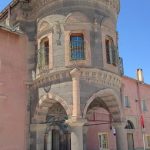“Sweet Valley” Population: 2,500
Old names: Mokisos, Justinianopolis, Örensar; Hardaldere, Halvadara
On the shores of a petite lake, the small settlement of Helvadere, southeast of Aksaray in Western Cappadocia, is not as pretty as its sweet name might suggest although you might like to take a quick look at the Yeni (Kilise) Cami, originally built in the 19th century as the Church of Agios Nikolaos (St Nicholas).
However, the main reason to come here is that Helvadere marks the access point for walks in the foothills of Hasan Dağı (Mt Hasan) as well as sitting just below the ruins of what is thought to be the Byzantine settlement of Nora, otherwise known as Viranşehir (Ruined City, not to be confused with places of the same name in Mersin and east of Şanlıurfa).
Backstory
It is not one hundred per cent certain that the ruins on the hill are of Nora but the settlement here certainly existed before the reign of Justinian, Nora was the religious centre for what was Koloneia and is now now Aksaray in Byzantine times. and it is thought that the emperor had the settlement relocated onto the slopes of Hasan Dağı for better protection. Today only ruins survive, hence the name Viranşehir. It appears to have been abandoned at the time of the Arab invasions of the seventh century.
Around the site
The ruins of Nora (if, indeed, this is Nora) squat on the hillside above Helvadere. A sign in the town points towards the steep walking trail leading to the site. There is also a rough track that can be used by most cars that will take you much closer to the unmarked path to the ruins. Note that it’s easy to go wrong as a deceptively good trail runs straight up the hill bypassing the ruins. Instead you need to look for a fairly steep and fairly narrow scree-covered path running off the track on the right. It passes between two hills to emerge in a meadow liberally scattered with rocks, which may or may not be ruins. You’ll see a pair of stone arches up on a ridge to reassure you that you’ve in the right place.
It’s not easy to identify most of the ruins – or even to distinguish them from old stone cattle pens and fallen boulders. However, you should be able to make out the remains of two Byzantine churches, the Kara (Black, early 5th century) and Kemer (Arched, late 4th century)) Kilises. There are also remains of what was once the Selçuk-era Karahan.
But really you come here for the glory of the setting with Hasan Dağı looming up above the ruins in a quiet unspoilt corner of Cappadocia.
According to Cappadocia: Travels in the Christian East, before the 1923 population exchange Christian villagers from Helvadere would come up to the Kemer Kilise every year on 23 April to celebrate the feast day of Hagios Giorgios (St George) with a fair.
Transport info and around Helvadere
You can get here by taxi from Aksaray or from Ihlara village which is much closer. It’s easy to visit the ruins of the Canlı Kilise above Akhisar on the way to or from Aksaray and you should be able to combine visits to both sites on the same trip. Alternatively you could visit the ruins of another forgotten Byzantine church, the Süt (Milk) Kilise, also in the foothills of Hasan Dağı. It was photographed by Gertrude Bell in 1907 and you could be forgiven for thinking that no one else has visited it since then. Bell also visited other ruined churches on the slopes of Hasan Daği. She described the one at Boz Daği – perhaps a small monastery – as being an hour’s climb above the Süt Kilise. Another was at Yağdebaşı. I haven’t visited either site so don’t know how much, if anything, survives of them.
